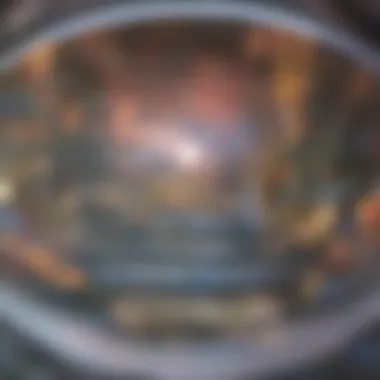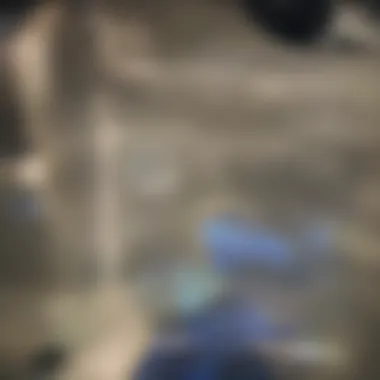Understanding the Water Window in Spectroscopy


Intro
The concept of the 'water window' plays a crucial role in infrared spectroscopy, serving as a vital framework for examining various substances. This zone occurs in the infrared spectrum, where water absorbs less light compared to other wavelengths. The water window, therefore, allows for clearer spectroscopy readings, making it particularly useful in environments where water is present, whether in biological or chemical contexts. Understanding this principle is essential for scientists and researchers looking to utilize infrared spectroscopy effectively.
Key Findings
Major Results
The investigation into the water window has revealed several key insights:
- Optical Transparency: In the spectral range of approximately 1,400 to 1,800 nanometers, the absorption of infrared light by water is considerably low. This transparency allows for effective analysis of biological tissues and other aqueous samples.
- Applications in Biology: In biological research, the water window is invaluable. It enables scientists to study live tissues without interference from the high water content typically found in these samples. This leads to improved identification of biochemical components.
- Advancements in Technology: Recent technological improvements, such as Fourier-transform infrared spectroscopy (FTIR), have optimized the use of the water window, making it easier for researchers to gather accurate data with minimal interference.
"The water window is like an open door in the infrared spectrum, providing unobstructed access to analyze aqueous environments effectively."
Discussion of Findings
The implications of these findings extend far beyond simple spectroscopy. For instance, the ability to observe chemical reactions in solutions can enhance knowledge in various fields including pharmacology and environmental science. Researchers can detect specific compounds and assess their interactions, providing valuable data for applications in drug development and pollution studies.
Methodology
Research Design
To explore the applications of the water window, researchers typically employ a range of methodologies. These often include experimental setups where different materials are tested under controlled conditions to measure absorbance and transmittance in the infrared spectrum. Comparative studies can highlight the advantages and limitations of using the water window in different scenarios.
Data Collection Methods
Data collection methods vary but generally encompass:
- Spectroscopic Analysis: Infrared spectroscopy is used to record how substances absorb infrared light, confirming or challenging existing theories regarding molecular behavior in the presence of water.
- Sample Preparation: Preparing samples to ensure consistency and reliability is critical. This may involve diluting samples or using specific concentration levels that can showcase the effects of water on analytical outcomes.
Understanding the Water Window
The concept of the water window plays a pivotal role in the domain of spectroscopy, particularly when focusing on infrared applications. By providing insight into molecular absorption characteristics, the water window allows researchers and practitioners in varied scientific fields to achieve a clearer understanding of materials and biological tissues in their natural environments. As this article delves into the intricacies of the water window, it is fundamental to grasp its definition, historical developments, and scientific principles at play.
Definition and Overview
The water window refers to a distinct region in the infrared spectrum, particularly between 1,400 and 1,900 nanometers. Within this range, water's absorption characteristics are minimal, allowing for the passage of infrared light. This transparency is significant because water is prevalent in many biological samples and material components. The visibility of molecular vibrations in this window enhances the capacity for molecular identification and characterization. Understanding this concept assists spectroscopy practitioners in utilizing infrared methods without interference from absorbent water molecules.
Historical Context
The origins of the water window can be traced back to the exploration of infrared spectroscopy in the 20th century. Early studies exposed how water interacts with infrared radiation, underscoring its high absorption at varying wavelengths. However, the identification of the water window was gradual. Researchers such as W. G. Fateley and others highlighted its utility in biological studies, leading to increased interest in utilizing infrared methods for analyzing materials without the distortions that water absorption can introduce. Over the years, advancements in detector and sensor technologies further promoted a deeper exploration into this specific band of the spectrum.
Scientific Principles Behind the Water Window
The scientific foundation of the water window is rooted in molecular vibrations and the interaction of light with matter. During infrared spectroscopy, when molecules absorb infrared light, they enter excited vibrational states. The unique vibrational signatures of water molecules occur outside the window's spectrum, which creates a favorable condition for analyzing other samples.
The effectiveness of applications within this window lies in leveraging the less absorbent regions of water, allowing scientists to observe organic compounds and biological specimens. This low absorption range yields higher signal-to-noise ratios, enabling clearer detection of molecular features. Understanding these scientific principles is crucial for utilizing the water window effectively:
- The vibrational transitions of molecules are influenced by bond strengths and masses, providing specific recognition patterns.
- The interactions with infrared light can be quantitatively measured using various spectroscopic methods, such as Fourier-transform infrared spectroscopy (FTIR).


By grasping these basics about the water window, scholars and practitioners can move towards exploring its broader applications in conjunction with modern technological advancements.
The Importance of the Water Window in Spectroscopy
The concept of the water window holds significant importance in the field of spectroscopy, especially within infrared spectroscopic techniques. This principle refers to the range of wavelengths in the infrared spectrum where water absorbs very little light. Understanding the water window provides crucial insights into various scientific fields by allowing researchers to study samples that are primarily aqueous in nature without interference from water vapor. This becomes particularly relevant in biological and environmental applications where water is a dominant component.
Spectroscopy, as a technique, relies heavily on the interaction of light with matter. In cases where water is prevalent, traditional spectroscopic methods may become hindered by water’s strong absorbance characteristics. The water window offers a solution to this problem by providing a transparent range that permits more effective analysis. Key applications and benefits can be observed across several domains, illustrating the versatility of this concept.
Infrared Spectroscopy: A Key Application
Infrared spectroscopy is one of the most prominent techniques that benefits from the concept of the water window. By utilizing the specific range where water absorption is minimal, researchers can probe into biological samples, helpful for understanding intricate biological processes. For instance, IR spectroscopy aids in studying proteins, lipids, and other biomolecules in their natural aqueous environments, leading to more accurate data collection.
The water window specifically overlaps with wavelengths around 1,400 to 2,500 nm. This range allows researchers to conduct experiments involving biological samples without excessive background interference from water. Such analytical capabilities make infrared spectroscopy an invaluable tool in life sciences.
Impact on Molecular Identification
The ability to identify molecules accurately is paramount in various scientific pursuits. The water window significantly contributes to this facet by allowing distinct spectral signatures to emerge with minimal interference from water. This clarity is beneficial in fields such as chemistry and material science, where molecular identification can inform researchers about the structural and dynamic properties of compounds.
For example, researchers can analyze the composition of complex mixtures in aqueous solutions, identify unknown substances, and evaluate the behavior of molecules upon changes in environmental conditions. The presence of a clean spectral response within the water window enhances the reliability and precision of molecular identification, thereby improving the quality of research outcomes.
Relevance in Environmental Studies
Environmental studies have found the water window to be an essential feature. In areas like monitoring water quality and analyzing pollutants, the ability to conduct measurements without interference from water is crucial.
For instance, researchers can utilize this transparency to detect contaminants in water samples, allowing for timely assessments of environmental conditions. Additionally, the water window can facilitate the study of atmospheric water vapor, advancing the understanding of climate processes. With the ability to measure specific compounds while minimizing the effects of water absorption, environmental scientists can develop more effective strategies for conservation and sustainability.
"The water window provides an essential framework that enhances the capacity and effectiveness of spectroscopic analysis across multiple disciplines. Its applications extend well beyond traditional spectroscopy, facilitating research in ecology, biology, chemistry, and beyond."
Technological Advances Enhancing the Water Window
The field of spectroscopy has seen significant evolution over the past decades, particularly regarding the water window's capabilities. These advances not only improve measurement precision but also expand the water window's applications across various scientific disciplines. Researchers benefit from these developments, leading to better understanding of complex molecular structures and their interactions in different states.
Spectroscopic Techniques Evolution
Spectroscopic techniques have become more sophisticated with time. One important evolution is in Fourier-transform infrared spectroscopy (FTIR). This method allows for the collection of spectra in a quicker and more effective manner than traditional methods. Nearly all complex samples can now be analyzed rapidly, allowing researchers to obtain information about sample identity and structure efficiently.
Another significant technique is near-infrared spectroscopy (NIRS), which has made it possible to apply the water window in detecting and quantifying biological compounds. This application is critical in life sciences and agriculture. As these techniques continue to develop, their capacity for in-depth analysis enhances significantly.
Instrumentation Improvements
Instrumentation in spectroscopy has particularly benefited from advances in technology. Current instruments have improved sensitivity and resolution. For example, detectors in modern spectrometers now feature advanced materials that offer better performance over a broader range of wavelengths. This improvement significantly enhances the detection capabilities of the water window, allowing for more precise measurements.
Additionally, the integration of portable spectrometers has expanded accessibility for field studies. Researchers can now perform measurements in various environments, enhancing the range of applications for the water window beyond laboratory settings. This flexibility is vital for real-time monitoring in environmental science, for instance.
Software Developments for Data Analysis
Along with advancements in hardware, software for data analysis plays a crucial role in leveraging the water window more effectively. Modern analytical software features powerful algorithms for processing spectral data, enabling more accurate interpretation of results.
These software tools enhance the capabilities to identify molecular signatures and analyze complicated mixtures. Automated data analysis reduces human error and allows researchers to draw conclusions with higher confidence. Tools that incorporate machine learning further refine data interpretation, providing insights that were previously unattainable. This integration of advanced software strengthens the impact of the water window in various scientific fields.


The continuous evolution of technological tools in spectroscopy is key to unlocking new applications and enhancing existing methodologies in studying the water window.
Applications of the Water Window Across Disciplines
The water window is a critical concept in various scientific fields due to its unique properties related to the interaction of infrared radiation and water. This section discusses the diverse applications of the water window across different disciplines, emphasizing its importance and potential benefits.
Chemistry and Material Sciences
In chemistry and material sciences, the water window serves as a crucial factor in spectroscopic analysis. It allows researchers to study aqueous solutions without interference from water's absorption bands. This property enables detailed investigations of molecular structures and dynamics in solutions. Moreover, the ability to analyze chemical reactions in real time is enhanced. Researchers gain insights into reaction mechanisms and kinetics, which are vital for developing new materials or pharmaceuticals.
Key benefits include:
- Non-destructive analysis: The water window permits examination of samples without altering their state.
- Increased sensitivity: Detecting lower concentrations of substances in water-rich environments is made easier.
- Expanded scope of study: More complex mixtures can be analyzed effectively, leading to advancements in areas like catalysis and nanotechnology.
Life Sciences and Biological Research
In life sciences, the water window plays a fundamental role in understanding biological processes. Its ability to penetrate tissue materials without significant distortion makes it invaluable for studying biological samples. For instance, researchers can investigate cellular processes, such as metabolic activities and molecular interactions, under physiological conditions. This capability enhances the understanding of drug interactions within cells and the evaluation of therapeutic efficacy.
Moreover, the water window facilitates imaging techniques such as infrared microscopy. This method allows scientists to observe living cells and tissues in real time, providing insights into disease mechanisms and potential treatments.
Medical Diagnostics and Healthcare Applications
The medical field benefits significantly from the water window, particularly in non-invasive diagnostic practices. Techniques like infrared spectroscopy are often used to analyze biological fluids, such as blood and urine. This application can be pivotal for detecting diseases at early stages, including cancers and metabolic disorders.
Moreover, advancements in point-of-care testing leverage the water window for rapid analysis of patient samples. These methods are critical in ensuring timely interventions, thus improving patient outcomes.
Industrial Applications
In industrial settings, the water window is utilized in quality control and process monitoring. The ability to analyze materials and mixtures without the confounding effects of water absorption supports sectors like food production and manufacturing. For instance, understanding the composition and quality of food products can be enhanced using water window techniques, ensuring adherence to safety and quality standards.
Furthermore, industries focused on chemical production rely on the water window for real-time monitoring of complex chemical reactions. This capability leads to better control over manufacturing processes, resulting in higher efficiency and reduced waste.
Overall, the applications of the water window extend far beyond laboratory settings, impacting both research and various practical fields. Its importance cannot be overstated as it enables advancements that would otherwise be challenging to achieve in the presence of water-related interference.
Challenges and Limitations of the Water Window
Understanding the challenges and limitations associated with the water window is critical for anyone engaged in spectroscopy. These obstacles can often impede effective measurements and interpretations, making it essential to navigate them thoughtfully. Each challenge offers a glimpse into the complexities of working within this critical area of research. The water window, while offering significant advantages, also presents specific technical and interpretative hurdles that must be managed to achieve meaningful results.
Technical Barriers in Measurement
One primary challenge in using the water window lies in the technical barriers that researchers face during measurement. Several factors contribute to these issues.
- Equipment Sensitivity: Instruments used for spectroscopic measurements can be sensitive to factors like environmental conditions and operational parameters. Variability in temperature and humidity can affect readings, leading to inaccurate data.
- Calibration Issues: Ensuring accurate calibration of devices is crucial. Improper calibration can create spectral artifacts that obscure the actual signals being measured. This can result in misinterpretation of data, making ongoing calibration and validation processes necessary.
- Sample Properties: The intrinsic properties of samples, including their thickness and composition, can also complicate measurements. Variations in water content, for instance, can influence the absorbance and transmission characteristics of samples, leading to inconsistent results.
Addressing these technical barriers requires continuous advancements in instrumentation and methodologies. Developing robust protocols for sample handling and processing, as well as employing more sophisticated spectrometric techniques, can mitigate some of these issues.
Interpretation of Data
The interpretation of data derived from the water window also presents a myriad of complexities. Distilling meaningful insights from spectroscopic data is not as straightforward as it might seem.


- Complex Spectral Overlaps: In the infrared region, spectra can often show overlapping absorption features. This complicates the identification of specific compounds and their concentrations. Differentiating between similar spectral signatures requires advanced analytical techniques and often additional data.
- Biological Variability: In biological research, variability among samples can introduce noise into data interpretation. Factors such as genetic diversity and environmental influences can alter how molecules behave under spectroscopy, thus impacting results that rely on spectra from various biological samples.
- Data Processing Limitations: The available software for analyzing spectroscopic data has limitations in terms of its ability to account for all possible variations and anomalies in the acquired data. This can lead researchers to overlook critical patterns or features.
The challenges tied to data interpretation necessitate a multidisciplinary approach, where collaboration between chemists, biologists, data scientists, and engineers can enhance understanding and potentially lead to improved analytical techniques.
Overall, while the water window holds significant promise, being aware of these challenges is fundamental for effective implementation in research and applications.
Future Directions in Water Window Research
The future direction of research surrounding the water window is critical for advancing our understanding of spectroscopy and its applications. This segment highlights various elements crucial for innovations and improvements in both scientific and technical fields. Benefits of exploring this area are profound; they promise not only enhanced measurement techniques but also broader interdisciplinary collaboration.
Innovations in Spectroscopy
Innovations in spectroscopy will likely play a pivotal role in fully leveraging the advantages of the water window. Researchers are continually experimenting with novel spectroscopic methods that refine sensitivity and resolution. Some potential innovations include:
- Quantum spectroscopy: This technique promises to elevate precision due to its ability to leverage quantum states of matter.
- Azimuthal angle scattering: Improved angular measurements could enhance detection capabilities through the water window.
- Novel light sources: Advancements in laser technology can yield new wavelengths that improve spectral analysis in the water window region.
Such innovations position the scientific community to uncover a myriad of previously unmeasurable molecular interactions and phenomena. Continuous investment in these areas can open new doors, extending the boundaries of infrared spectroscopy.
Integration with Other Technologies
Integration of the water window research with other emerging technologies can significantly bolster its applications and findings. For example:
- Artificial intelligence: AI can help in interpretating large sets of spectral data more efficiently, reducing the time from measurement to actionable insight.
- Nanotechnology: Coupling nanomaterials with spectroscopic techniques can enhance sensitivity, allowing detection of smaller quantities of analytes.
- Imaging technologies: fusing imaging and spectroscopy can provide spatial distribution data alongside spectral information, enriching the analytical process.
The convergence of these technologies with water window research creates a synergistic potential that can result in revolutionary advancements across several domains, such as environmental monitoring and materials science.
Expanding Research Collaborations
The water window's scientific potential is best unlocked through collaborative efforts across various disciplines. Areas where collaboration is beneficial include:
- Biomedical research: Using infrared spectroscopy in this field can lead to breakthroughs in disease diagnostics.
- Environmental science: Collaborative research can ensure effective monitoring of water quality and other environmental factors.
- Material science: Sharing insights among chemists and physicists can yield new materials that are designed with specific spectroscopic properties in mind.
In essence, fostering a network of collaborations is key to harnessing the full benefits of the water window in spectroscopy. Ultimately, substantial contributions can be made to scientific knowledge through collective expertise.
Through innovative approaches, integrated technologies, and collaborative networks, the exploration of the water window promises not just potent advancements in spectroscopy, but also transformative impacts across various scientific disciplines.
Closure Extrapolating Insights from the Water Window
The water window is not just a scientific curiosity; it is a crucial concept in various fields of study, particularly in spectroscopy and environmental science. It represents a specific range of wavelengths that allow for the transmission of infrared light through water, making it an invaluable asset in analyzing biological and ecological processes. Understanding the water window facilitates more effective exploration of molecular structures and interactions. As discussed throughout this article, its importance spans the realms of chemistry, biology, and medical diagnostics, providing insights into both fundamental research and practical applications.
Summary of Key Points
In summarizing the critical aspects of the water window, several points stand out:
- The water window allows infrared light to penetrate water, enabling detailed spectral analysis.
- Its applications are broad, covering fields such as chemistry, material sciences, and life sciences.
- Technological advancements have significantly enhanced the methods of measurement and data analysis relating to this phenomenon.
- Challenges exist, including technical barriers and the need for careful data interpretation.
- Future research directions indicate promising innovations and interdisciplinary collaborations that can enrich our understanding of the water window and its applications.
Implications for Future Research
Looking forward, the exploration of the water window holds significant promise. Continued innovations in spectroscopy techniques are expected to yield finer analyses of complex biological and chemical systems. Integrating these techniques with new technologies, such as artificial intelligence for data processing and analysis, will likely emerge as a predominant trend.
Furthermore, expanding research collaborations across disciplines can enhance insights into environmental monitoring and health diagnostics. As researchers continue to uncover the potential applications of the water window, its role in shaping future studies in molecular identification, medical insights, and ecological assessments will become increasingly relevant.
As science progresses, the water window will remain a focal point, encouraging deeper inquiries and fostering advancements that could profoundly impact multiple scientific domains.
"The water window not only defines a spectral range but also symbolizes the intersection of technology and biological insight, paving the path for future discoveries."
By embracing this concept, scientists can open new doors in research, leading to significant strides in understanding biological processes and materials science.



